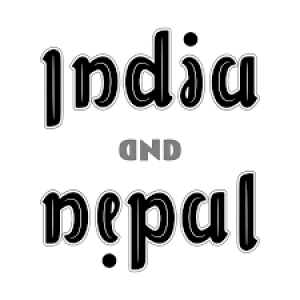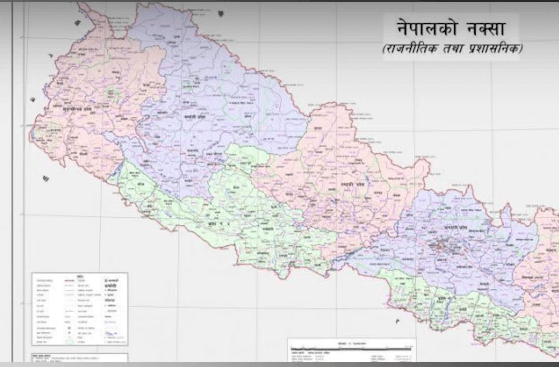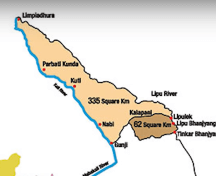India Nepal Border Issue | India vs Nepal Relationship & Border dispute

Share
Introduction
In this article you find a better understanding on the ongoing border dispute, special about the disputed area, who is right in this scenario- India or Nepal.
India Nepal Relationship & Border dispute
The kind of close relations India has shared with Nepal historically, has not been shared with any other country. Not only can Indians and Nepalese can cross each other's borders without a visa, they can also reside and work in each other's countries. But these relations have begun to sour over the past few days and years. Recently, the Prime Minister of Nepal claimed that India is responsible for the spread of corona virus in Nepal. Furthermore, the Prime Minister of Nepal has accused India of occupying some area of Nepal. A border dispute is brewing between both the countries
So what is this border dispute? Why did it start? And who is right in this scenario- India or Nepal?
We will try and find out about all of this in this article.
This controversy surfaced within the Indian media when Nepal came out with its new map a few days ago.

They came out with a new map of their country and within it, they included an area which they hadn't earlier the area which is under India's control today. If you look at their new map, this area is a triangular shaped disputed area in the north western tip of Nepal. This area is the eastern most tip of Uttarakhand. This entails an area of around 300 square kilometres And the northmost village/place is Limpiyadhura The south- eastern part of it is Lipulekh pass Gunji lies in the south west and Kalapani in the south So this area has been defined on the basis of these three places- Limpiyadhura, Lipulekh and Kalapani. Nepal believes that this area rightfully belongs to Nepal whereas as India believes it is India's. Before we address the question of who is right and what the history of this land is, First, I'd like to tell you that this controversy broke out due to two events which happened around 6 months ago.
The first event happened on November 2019
The Modi government released a new map of India, in which the region of Kalapani was claimed to be under India, which triggered the Nepal government
The second event happened on 8th May, 2020
when the Indian Defense Minister inaugurated a new road, This road was around 80 kilometres along the India- Nepal border through this disputed area uptil Lipulekh. The purpose of this road was to aid the people on the Kailash Mansarovar Yatra as per claims Because above this disputed area lies Tibet, where the Kailash Mansarovar is situated Before the construction of this road, the yatris had to go to the Kailash Mansarovar via Sikkhim. It was a trek of 5 days. After the construction of this road, they will reach China's border in a car, which will be followed by a mere 2 day trek.
After the inauguration of this road, the Nepal government was upset as they believed that Lipulekh pass comes under Nepal and they also believed that if India had to construct this road, they should have consulted Nepal first and worked out an agreement before doing this.
In response to this, the external affairs ministry of India said that this area comes completely under the territory of India and therefore they did not hold a consultation with Nepal This was not required because they had constructed a road within their own territory.
But situations began to go from bad to worse when protests regarding this erupted in Nepal The Army chief of 15th May, said that the protests in Nepal were influenced by China.
This further upset the people in Nepal and then the Nepal government released this new map which brought the entire dispute to light.
So the question is that why is this disputed region actually disputed? And which country does it rightfully belong to?
Come, let us go through its history first.
Our story begins in the 1800s, around two hundred years ago, when India was under British rule
The Britishers were trying to expand towards Nepal which was under a kingdom then- The kingdom of Gorkha A battle took place between the Britishers and the Kingdom of Nepal which is called the Anglo Nepalese war of 1814. This battle raged for two years- until 1816- after which, a treaty was signed - Treaty of Sugauli- to decide which areas would be controlled by the Britishers. and which areas would be controlled by the Kingdom of Nepal. How much area would be assigned to both the countries at that time
According to the treaty of Sugauli, Nepal lost its area of Sikkhim and Darjeeling That area was ceded to the Britishers And two rivers were made use of to define the kingdom of Nepal. The western boundary of Nepal would be along the Mahakali river and the eastern boundary would be along the Mechi river. Even today, if you observe what the eastern and western boundaries of Nepal and India are then they are defined according to these two rivers The Nepal- India border runs along the rivers.

The problem arises at the Western border of Nepal- if you go along the Mahakali river So, this river actually comes from two sources
Which source should be chosen to define the border?
So in the beginning, this is what the Britishers did The thicker part of the river, which lies on the west was used to define the border. In the maps drawn by the Britishers, the west river was used to define the border And Nepal got this extra region. That is, this extra triangular part which the controversy is about- went to the Nepal kingdom.
But the story is not so simple. Some years later, the Britishers realized that the extra piece of land that they had ceded to the Nepal kingdom They needed it. This land held a lot of strategic importance because it would be useful while trading with China. So, some 30-40 years later, in the 1860s, the Britishers changed their maps suddenly with a lot of cunning. Almost suddenly, they claimed the eastern river to be the boundary in their maps the eastern river was used by the Britishers as a boundary between British India and the Kingdom of Nepal.
The Kingdom of Nepal did not have a problem with this at that time, because it was a small piece of land and it wasn't of much ue from the perspective of Nepal Almost no one lived there. It was an extremely difficult terrain and only one path crossed through it- the pilgrimage route to reach Mansarovar. So Nepal thought of letting it go as it did not make much of a difference to it They let the Britishers control it. And that was considered as the border from then, until India got its independence from the British rule.
And the same border continued to be considered even after India became independent. The monarchs of Nepal Democracy came to Nepal pretty late. It became a democratic country in 1990.
Before that, a monarchy was in power So even the monarchs of Nepal did not have an issue with this unofficial border. They kept this area out of Nepal while drawing their government maps. When tensions intensified between India and China in the 1960s, which ultimately led to an Indo-China war, then a military post was established by the Indian army in this area. Permission was sought from the Nepal monarchy- which again, did not have a problem with this. They gave permission for this for the protection of India. And ever since then, there is a presence of the Indian army in this area and there are established Indian military posts.
1962 onwards, both India and Nepal have been showing Lipulekh and Kalapani in their respective maps. But this is the first time that Nepal has shown the Limpiyadhura region in its map.The issue of this border dispute first reared its head in the 1990s when democracy came to Nepal. The democratic government was able to finally access the old historical papers to see how their monarchy defined their borders and then they realized that this area should belong to Nepal and ever since then, they have been defining this as a disputed area
In July 2000, the former Indian Prime Minister Atal Bihari Vajpayee ji and the then Nepali Prime Minister discussed upon this issue to solve the border dispute. They conducted a joint field survey to figure out where the exact boundary should be in the Kalapani region But this agreement got clamped in the middle when India refused to withdraw its army presence from there So discussions could not continue further.
In May 2015, India and China signed a trade agreement to use the Lipulekh pass as a trade route And this is the point when the India and Nepal relations began to sour. In 2015, the then Prime Minister of Nepal expressed his displeasure over the issue and showed objection. He claimed that the Kalapani region came under the ambit of Nepal. He protested in relation to this against both India and China.
So the biggest question is who does this disputed area rightfully belong to- India or Nepal?
Nepal argues that the Sugauli treaty was the last treaty in which both sides were in agreement After that, there has been no treaty in which both sides are in agreement And so they would take the Sugauli treaty as a base and on that basis, this area should be theirs because The treaty defines that their western boundary would be along the Mahakali river. And where this river is divided into two, it is clearly visible that the wider river is the Mahakali river and so this area comes under them.
The argument in India's favour is that Nepal said nothing regarding this for so many years This border has been in use for decades After the 1860s, this has been the unofficial boundary in use Nepal didn't object then. Neither did the monarch of Nepal have a problem with that.
So what is the logic behind raising this issue suddenly and raising a dispute for nothing?
In counter to this, Nepal could argue that democracy came to Nepal in the 1990s Prior to that, the monarch ruled and he exercised his own will The people's will was never paid heed to Now that they have democracy, why should they obey the monarch if he agreed to an unofficial boundary?
Here, another argument in India's favour would be that even after 1990s, when Nepal had become democratic, Nepal had not declared the Limpiyadhura under it for so many years So what changed so suddenly that it called for a new political map?
So these are the arguments of both the sides
Who does the disputed border area rightfully belong to, in your opinion? India or Nepal?
viewed geographically, then Nepal is correct in this situation If we go according to the Sugauli treay, which states that the western boundary of Nepal would be defined according to the Mahakali river So it is quite clear that where the river is divided into two, the western river is the bigger one and that should be used as a boundary. And according to this logic, Nepal is right.
But if this situation is viewed practically and historically, then India is right. This region should belong to India because the British too have been using this as a boundary since 1860s And if the monarchs of Nepal did not have an issue with it and this unofficial border was in use since many years So if suddenly Nepal begins to claim that they want the 100 year old border, then it doesn't make any sense.
If every country begins to behave this way, then things will not work out Think about it- if such a situation arises between Germany and France, where Germany claims a particular region under France to be its own because that region was under them during the times of their older kingdoms Although, it was not under them for the past hundred years, they now stake a claim over it Things will not work out this way- there must be so many such countries and borders across the world where things were different earlier but something new has been set now.
Thirdly, if you think logically, then this controversy should not have arisen The border between India and Nepal is for namesake. Indians and Nepalis can anyway cross the border without a visa or passport and can reside and work there.
So what would be so special about the disputed area?
The Nepalis and the Indians can live and work there even today if they wish to Both the Nepalis and the Indians can use the road which has been constructed So what is the controversy about, then?
Only about representing it on their political maps
One thing here is that the Indian government should have been more friendly with the government of Nepal Talks about the construction of the road could have been held with Nepal prior to constructing it and that both countries would benefit from it that the road was being constructed for their pilgrims of the Mansarovar and that this place was also of strategic importance to them. So an agreement could be reached together.
But what is happening today is that Indians are making fun of Nepalis on social media and abusing them Nepalis are writing hate comments against Indians Some Indian politicians are saying that these Nepalis have been sold off to China The Prime Minister of Nepal said that the Indian virus was deadlier than the Corona virus
A friendship cannot be maintained among both the countries in this manner And a friendship is essential because Indians and Nepalis are so integrated with one another
Think about it- so many Nepalis are employed even in the Indian army
about the point of China
once Some Indians say that the Chinese have bought over the Nepalis because the ruling party in Nepal at present is a communist party and since there is also a ruling Communist party in China, it is being said that a Chinese influence is being exerted on Nepal It might be true to some extent in the rest of the issues
But talking about this specific issue- the ongoing border dispute
China has nothing to do with this And what are the reasons behind this?
First of all, when there was a trade agreement between India and China in 2015, regarding the Lipulekh region then Nepal had protested against both the countries And India and China were forming relations with one another while Nepal was against both of them
And the second reason is that the opposition party in Nepal holds the same opinion regarding this issue that the ruling party adheres to Almost all the parties there are united over this issue That they believe this area to be theirs.
So then, saying that China has influence over one party makes no sense. There is no logic to this.
I hope that these two countries solve this issue through discussions. This is very important because the connection/relation between Indians and Nepalis is very strong and deep Several Nepalis work in India and under the Indian government as well as in the army.
Both sides would have to remain sensitive while solving this issue and would have to understand one another and understand each other's perspectives so that a solution can be worked out.
Conclusion
In this article you find a better understanding on what is going on india & nepal border issue, what are relations india made with nepal, the ongoing border dispute, special about the disputed area, who is right in this scenario- India or Nepal.
